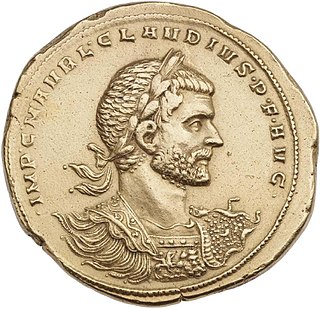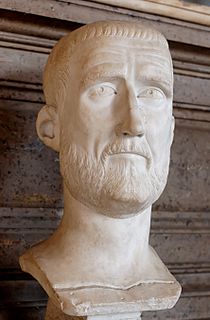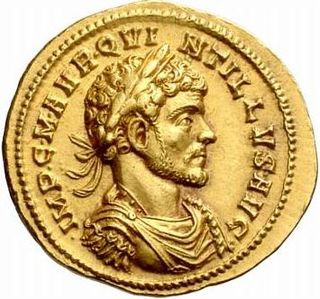Related Research Articles

Ambrosius Aurelianus was a war leader of the Romano-British who won an important battle against the Anglo-Saxons in the 5th century, according to Gildas. He also appeared independently in the legends of the Britons, beginning with the 9th-century Historia Brittonum. Eventually he was transformed by Geoffrey of Monmouth into the uncle of King Arthur, the brother of Arthur's father Uther Pendragon, as a ruler who precedes and predeceases them both. He also appears as a young prophet who meets the tyrant Vortigern; in this guise, he was later transformed into the wizard Merlin.

Publius Licinius Egnatius Gallienus was Roman emperor with his father Valerian from 253 to 260 and alone from 260 to 268. He ruled during the Crisis of the Third Century that nearly caused the collapse of the empire. He won a number of military victories against usurpers and Germanic tribes, but was unable to prevent the secession of important provinces. His 15-year reign was the longest in half a century.

Marcus Claudius Tacitus was Roman emperor from 275 to 276. During his short reign he campaigned against the Goths and the Heruli, for which he received the title Gothicus Maximus.
The 270s decade ran from January 1, 270, to December 31, 279.

Year 271 (CCLXXI) was a common year starting on Sunday of the Julian calendar. At the time, it was known as the Year of the Consulship of Aurelianus and Bassus. The denomination 271 for this year has been used since the early medieval period, when the Anno Domini calendar era became the prevalent method in Europe for naming years.

Septimia Zenobia was a third-century queen of the Palmyrene Empire in Syria. Many legends surround her ancestry; she was probably not a commoner and she married the ruler of the city, Odaenathus. Her husband became king in 260, elevating Palmyra to supreme power in the Near East by defeating the Sassanians and stabilizing the Roman East. After Odaenathus' assassination, Zenobia became the regent of her son Vaballathus and held de facto power throughout his reign.

Aurelian was a Roman emperor, who reigned during the Third Century Crisis, from 270 to 275. As emperor, he won an unprecedented series of military victories which reunited the Roman Empire after it had practically disintegrated under the pressure of barbarian invasions and internal revolts.

Marcus Aurelius Claudius "Gothicus", also known as Claudius II, was Roman emperor from 268 to 270. During his reign he fought successfully against the Alemanni and decisively defeated the Goths at the Battle of Naissus. He died after succumbing to a "pestilence", possibly the Plague of Cyprian that had ravaged the provinces of the Empire.

Marcus Aurelius Probus was Roman emperor from 276 to 282. Probus was an active and successful general as well as a conscientious administrator, and in his reign of six years he secured prosperity for the inner provinces while withstanding repeated invasions of barbarian tribes on almost every sector of the frontier.

The Gallic Empire or the Gallic Roman Empire are names used in modern historiography for a breakaway part of the Roman Empire that functioned de facto as a separate state from 260 to 274. It originated during the Crisis of the Third Century, when a series of Roman military leaders and aristocrats declared themselves emperors and took control of Gaul and adjacent provinces without attempting to conquer Italy or otherwise seize the central Roman administrative apparatus.

Marcus Aurelius Claudius Quintillus was a Roman emperor. He was a brother of Emperor Claudius Gothicus, whom he succeeded after Claudius' death in 270. Quintillus' claim to be emperor was challenged by Aurelian, who was proclaimed emperor by the legions he commanded. Quintillus' reign lasted no more than six months. Different sources report his cause of death as murder by his own soldiers, in battle with Aurelian, or by suicide.

Domitian II was probably a Roman soldier of the mid 3rd century who was acclaimed emperor, probably in northern Gaul in late 270 or early 271, and struck coins to advertise his elevation. It is now generally assumed that this man is to be equated with the Domitianus who is twice mentioned in the literary sources as a significant figure in the politics of the age, but on neither occasion as an outright contender for the Imperial throne.

Marcus Piavonius Victorinus was emperor in the Gallic provinces from 268 to 270 or 269 to 271, following the brief reign of Marius. He was murdered by a jealous husband whose wife he had tried to seduce.

Gaius Pius Esuvius Tetricus was the emperor of the Gallic Empire from 271 to 274 AD. He was originally the praeses (governor) of Gallia Aquitania and became emperor after the murder of Emperor Victorinus in 271, with the support of Victorinus's mother, Victoria. During his reign, he faced external pressure from Germanic raiders, who pillaged the eastern and northern parts of his empire, and the Roman Empire, from which the Gallic Empire had seceded. He also faced increasing internal pressure, which led him to declare his son, Tetricus II, caesar in 273 and possibly co-emperor in 274, although this is debated. The Roman emperor Aurelian invaded in 273 or 274, leading to the Battle of Châlons, at which Tetricus surrendered. Whether this capitulation was the result of a secret agreement between Tetricus and Aurelian or necessary after his defeat is debated. Aurelian spared Tetricus, and even made him a senator and corrector (governor) of Lucania et Bruttium. Tetricus died of natural causes a few years after 274.

Septimius Vaballathus was emperor of the Palmyrene Empire centred at Palmyra in the region of Syria. He came to power as a child under his regent mother Zenobia, who led a revolt against the Roman Empire and formed the independent Palmyrene Empire.
Taurinius was a Roman usurper who revolted against Severus Alexander in 232 AD. He was declared emperor by the legions stationed in Roman Mesopotamia when they rebelled, due to the invasion of the Sassanids in 229 AD. His revolt was swiftly crushed by Alexander, in late summer of 232 AD, and he drowned in the Euphrates while attempting to flee to Sassanid territory.

Victoria, also known as Vitruvia, was a leader in the Roman breakaway realm known as the Gallic Empire in the late 3rd century. She was the mother of Victorinus, who ruled as Gallic Emperor until his assassination in 271. Afterwards, Victoria used her authority to stabilize the empire and select a successor.
Ulpia Severina, also known as just Severina, was Roman empress as the wife of Roman emperor Aurelian from c. 270 to 275. Severina is unmentioned in surviving literary sources and known only from coinage and inscriptions and as a result, very little is known about her. Her nomen Ulpia suggests that she may have been related either to Emperor Trajan or the usurper Laelianus, as they share the same nomen, and perhaps from Dacia, where the name was common. It is not known when she married Aurelian, but it might have been before he became emperor. She was probably proclaimed Augusta in the autumn of 274.
Gaius Valarius Sabinus was a public officer in Ancient Rome, during the reign of Emperor Aurelian. After the revolt of Felicissimus and the mint workers in the spring of 271, Aurelian appointed Sabinus as the new finance minister. He was first given the title agens vice rationalis. This suggest he was given the office in the immediate aftermath of the riots. Later his position was confirmed officially, when he was given the title of v.p. rationalis.
References
- 1 2 Bond, Sarah (2016). Trade and Taboo: Disreputable Professions in the Roman Mediterranean. Ann Arbor: University of Michigan Press. p. 133. ISBN 978-0-472-13008-5.
- 1 2 Syvänne, Ilkka (2020). Aurelian and Probus: The Soldier Emperors Who Saved Rome. Yorkshire: Pen and Sword Military. p. 84. ISBN 978-1-5267-6750-9.
- ↑ White, John F. (2015). The Roman Emperor Aurelian: Restorer of the World. Yorkshire: Pen and Sword. ISBN 978-1-4738-4477-3.
- "Felicissimus", s.v. "Aurelian", De Imperatoribus Romanis site.
- Cyprian Discusses how Felicissimus presented a challenge to Cyprian's position of bishop in the church at Carthage [ citation needed ]